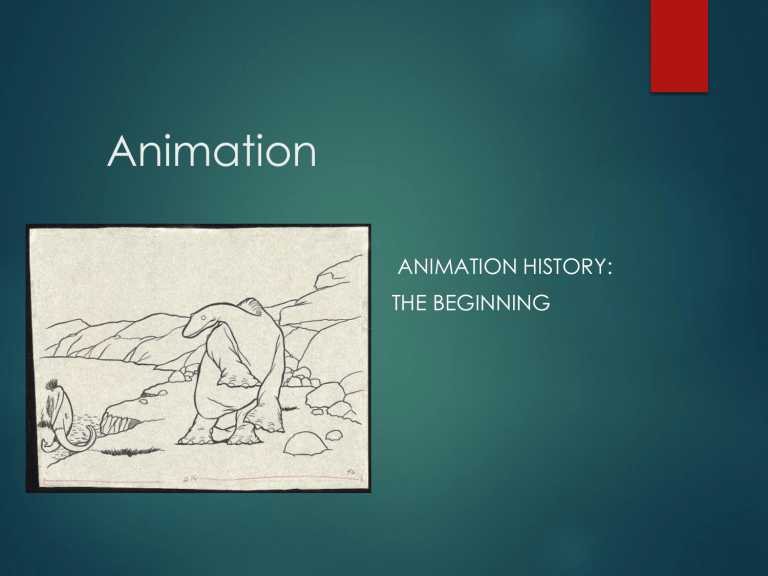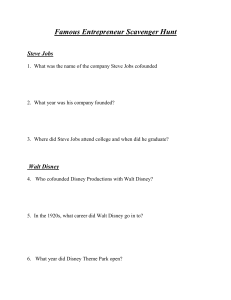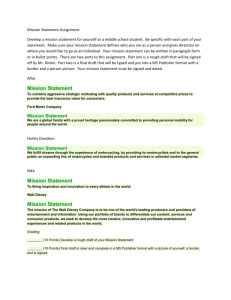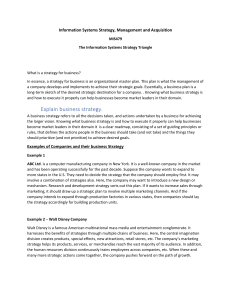
Animation ANIMATION HISTORY: THE BEGINNING Thaumatrope This device was created in 1827 by English physician John Ayerton Paris which has two different drawings on opposite sides of a disk. When the disk is spun, the images merge into one. Paul Roget used the thaumatrope in 1828 to demonstrate his persistence of vision concept. Image 02. Used with permission. Phenakistoscope In 1832, Belgian physicist Joseph Plateau and his sons introduced the phenakistoscope ("spindle viewer"). It was also invented independently in the same year by Simon von Stampfer of Vienna, Austria. The phenakistoscope used a spinning disc attached vertically to a handle. The user would spin the disc and look through the moving slits at the disc's reflection in a mirror. Image 03. Public Domain. Zoetrope This device was invented in 1834 by William Horner, who originally called it a Daedalum ("wheel of the Devil"). Later, it was renamed the "zoetrope," or "wheel of life." It was more convenient since it did not require a mirror and allowed more than one person to use it at the same time. It consisted of a cylinder with slits cut vertically in the sides. As it would spin, the user looked through the slits at the pictures across. Praxinoscope The praxinoscope was invented in France in 1877 by Charles-Émile Reynaud. This improved on the zoetrope by replacing its narrow viewing slits with an inner circle of mirrors, placed so that the reflections of the pictures appeared more or less stationary in position as the wheel turned. In 1889 Reynaud developed an improved version capable of projecting images on a screen from a longer roll of pictures. Birth of Photography Animation on film was only possible because of invention of photography in 1827 by Joseph Niépce. Louis Daguerre, an assistant to Niépce, developed a new process for developing images in 1837 called tin-type photos, also known as Daguerre-types. Improvement of Photography The technology behind photography improved dramatically in the last half of the 19th century. During the American Civil War (1860-1865), New York photographer Matthew Brady became well-known by taking photos of the war. In 1885, George Eastman introduced transparent, flexible film and in 1888 marketed his Kodak camera, bringing photography to the average American. Eadweard J. Muybridge Well known as a photographer in California, Muybridge was hired by former governor Leland Stanford to photograph the governor’s race horse. Stanford had a wager that all four hooves of a horse leave the ground when running. Muybridge’s job was to prove the theory. Using twenty-four cameras, a system of trip shutters, and high speed film, Muybridge’s series of still photographs gave the impression of motion. Muybridge Horse in Motion Image 11. Public Domain. Motion Pictures in America America’s premier inventor, Thomas Alva Edison, developed a motion picture camera (the kinetograph) and a projector (the kinetoscope) in 1891. Edison filmed random events including haircuts, boxing matches, Annie Oakley, and the new Brooklyn Bridge. Birth of Narrative Films By the turn of the century, the subject of motion pictures evolved towards narrative stories. The Edison 1902 film, “Fun in a Bakery Shop” was an early example of movie special effects. In 1903, the landmark silent movie “The Great Train Robbery” debuted. It was created by former Edison cameraman Edwin S. Porter, was a commercial success, and led to the birth of silent pictures. Motion Pictures in France Auguste and Louis Lumiere were French inventors and pioneer manufacturers of photographic equipment who devised an early motion-picture camera and projector. In 1895, they created the film “Workers Leaving the Factory” which is considered the first motion picture. In 1903, they turned their attentions away from cinematography and patented a color photography process that launched in 1907. Georges Méliès After seeing the Lumiere’s new invention in 1895, Georges Méliès began making films. He had been a magician and expert in special effects for the theater. In 1902, Georges Méliès made his most famous film, “A Trip to the Moon.” The film included the celebrated scene in which a spaceship hits the man in the moon in the eye. It was loosely based on works by Jules Verne and H. G. Wells. J. Stuart Blackton Blackton started as a vaudeville performer known as “The Komikal Kartoonist” who drew lightning-fast sketches. After meeting Edison, Blackton became interested in putting his drawings on film. “The Enchanted Drawing” was an early attempt at animation and special effects. In 1906 using a chalkboard, Blackton created “Humorous Phases of Funny Faces” which was known as the first animated film. “The Haunted Hotel” in 1907 expanded on the use of stop motion in films. Émile Cohl Eugène Jean Louis Courtet, who went by the pseudonym Émile Cohl, was a French caricaturist, cartoonist, and animator. After seeing a screening of Stuart Blackton’s “The Haunted Hotel,” Cohl began animating. In 1908, Cohl created “Fantasmagorie.” This animation was created using an illuminated glass plate for his table while drawing black lines on paper. The end result was printed in negative to intentionally give the feel of a chalkboard. The title referred to a fantasmograph, which was an early animation machine similar to a zeotrope. Winsor McCay McCay worked as a cartoonist for several newspapers. In 1912, McCay animated “How a Mosquito Operates.” In 1914, McCay brought “Gertie the Dinosaur” to life on film. It was included in his vaudeville act along with camera tricks where McCay appeared on screen with Gertie. McCay used animation to illustrate the “Sinking of the Lusitania” in 1918. Silent Movie Era of the 20’s In the 1920s, movie theatres popped up around the country. Sound was not added until 1927; all of the movies were silent. Before each movie, theatres usually showed several cartoons as well as news reels. Because of the popularity of movies, there became a strong demand for animated cartoons. The first studios were based in New York. Most studios relocated to California to take advantage of the good weather. Celluloid From 1914 through 1920, several film and animation houses were started in New York. The John Bray Studio was one of the most influential studios with its cartoon series, “Colonel Heeza Liar.” In 1914, Bray employee Earl Hurd invented the process of inking the animator’s drawings onto clear pieces of celluloid and then photographed them over a single painted background. This simplified the animation process. Otto Messmer In 1919, Otto Messmer created Felix the Cat for the Pat Sullivan Studios. Unlike Winsor McCay’s “Gertie the Dinosaur,” Felix the Cat was a studio character. This meant that audiences could look forward to seeing him again and again. Felix was also exposed to audiences across the country. One good example of an early cartoon was the 1923 release of “Felix in Hollywood.” Fleischer Studios Max and Dave Fleischer created “Koko the Clown” and the “Out of the Inkwell” series in the 1920’s. Max Fleischer invented the rotoscope; a machine that allowed an artist to trace over the live action from a movie film. The Fleischer brothers would have success in the 1930s with Betty Boop and her spinoff character, Popeye the Sailor Man. Image 27. Public Domain. Image 28. Public Domain. Walt Disney In 1923, Walt Disney relocated to Southern California, following the lead of many motion picture studios. In 1928, Disney was one of the first to use sound with the release of “Steamboat Willie.” In 1929, he used an entire symphony orchestra for the background music in “The Skeleton Dance.” This was the first cartoon in his series of “Silly Symphonies.” In 1932, “Flowers and Trees” was the first cartoon released in color. It won the first Academy Award presented to a cartoon. Walt Disney In 1937, Disney released the first full-length animated feature film. During his life, Disney released 19 animated feature films. He came up with several innovated techniques for making animated movies including: o the pencil test o the storyboard o the multi-plane camera The Golden Age of Animation (1930’s – 1950’s) By the 1930s, many film studios were in California and had their own animation departments. The major animation studios were: Disney Studios Warner Brothers (Leon Schesinger) Metro-Goldwyn-Mayer Universal Studios (Walter Lantz) Academy Awards for Best Animated Short (19321950) 1932 Flowers and Trees - Walt Disney Productions, United Artists - Walt Disney 1933 Three Little Pigs - Walt Disney Productions, United Artists - Walt Disney 1934 The Tortoise and the Hare - Walt Disney Productions, United Artists - Walt Disney 1935 Three Orphan Kittens - Walt Disney Productions, United Artists - Walt Disney 1936 The Country Cousin - Walt Disney Productions, United Artists - Walt Disney 1937 The Old Mill - Walt Disney Productions, RKO Radio - Walt Disney 1938 Ferdinand the Bull - Walt Disney Productions, RKO Radio - Walt Disney 1939 The Ugly Duckling - Walt Disney Productions, RKO Radio - Walt Disney 1940 The Milky Way - Metro-Goldwyn-Mayer - Fred Quimby & Rudolph Ising 1941 Lend a Paw - Walt Disney Productions, RKO Radio - Walt Disney 1942 Der Fuehrer's Face - Walt Disney Productions, RKO Radio - Walt Disney 1943 The Yankee Doodle Mouse - Metro-Goldwyn-Mayer - Fred Quimby 1944 Mouse Trouble - Metro-Goldwyn-Mayer - Fred Quimby 1945 Quiet Please! - Metro-Goldwyn-Mayer - Fred Quimby 1946 The Cat Concerto - Metro-Goldwyn-Mayer - Fred Quimby 1947 Tweetie Pie - Warner Bros. - Edward Selzer 1948 The Little Orphan - Metro-Goldwyn-Mayer - Fred Quimby 1949 For Scent-imental Reasons - Warner Bros. - Edward Selzer 1950 Gerald McBoing-Boing - United Productions of America, Columbia - Stephen Bosustow Public Domain Films Many of the early films are in the public domain and can be found online. It is important to note that some cartoons made during this time period lack political correctness and depict racism. The films listed below should be safe for students to view. Teachers should screen any video prior to showing it to the class. Here is a list of public domain films listed in this lesson: Various early Edison Films Fun at the Bakery Shop – Thomas Edison The Great Train Robbery – Edwin S. Porter Workers Leaving the Factory – Auguste and Louis Lumière Trip to the Moon – Georges Melies The Enchanted Drawing – J. Stuart Blackton Humorous Phases of Funny Faces – J. Stuart Blackton The Haunted Hotel – J. Stuart Blackton Fantasmagorie – Emile Cohl How a Mosquito Operates – Winsor McCay Gertie the Dinosaur – Winsor McCay Sinking of the Lusitania – Winsor McCay Colonel Heeza Liar – John Bray Felix in Hollywood – Pat Sullivan


